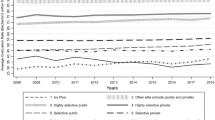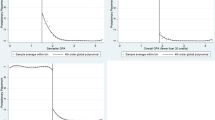Abstract
This study models graduation rates at 4-year broad access institutions (BAIs). We examine the student body, structural-demographic, and financial characteristics that best predict 6-year graduation rates across two time periods (2008–2009 and 2014–2015). A Bayesian model averaging approach is utilized to account for uncertainty in variable selection in modeling graduation rates. Evidence suggests that graduation rates can be predicted by religious affiliation, proportion of students enrolled full-time, socioeconomic status of the student body, enrollment size and institutional revenue and expenditures. Findings also demonstrate that relatively fewer variables predict institutional graduation rates for Latina/o and African American students at 4-year BAIs. We conclude with implications for policy and key recommendations for research focused on 4-year BAIs.
Similar content being viewed by others
Notes
Percentage of missing values was less than one percent (.39). Between 0 and 4% of data were missing across variables. Data were assumed to be missing at random (MAR). All candidate variables were used in the imputation model which converged in three iterations (−2 Ln(L) = 36328.659).
R Code: bai = bms(bai, burn = 100,000, iter = 50,000, nmodel = 500, mcmc = "bd", g = "UIP", mprior = "random", mprior.size = NA, user.int = TRUE, start.value = NA, g.stats = TRUE, logfile = FALSE, logstep = 10,000, force.full.ols = FALSE, fixed.reg = numeric (0), data = NULL, randomizeTimer = TRUE).
References
Abdul-Alim, J. (2014). Scholars: Proposed college rating system penalizes Minority-Serving Institutions. Diverse issues in higher education. Retrieved September 2014, from http://diverseeducation.com/article/66685/.
Adelman, C. (1999). Answers in the toolbox: Academic intensity, attendance patterns, and Bachelor’s degree attainment. Washington, DC: U.S. Department of Education.
Allison, P. D. (2012). Handling missing data by maximum likelihood. Retrieved from http://www.statisticalhorizons.com/wp-content/uploads/MissingDataByML.pdf.
Alon, S., & Tienda, M. (2005). Assessing the “mismatch” hypothesis: Differences in college graduation rates by institutional selectivity. Sociology of Education, 78(4), 294–315.
Arum, R., & Roksa, J. (2015). Measuring college performance. In M. W. Kirst & M. L. Stevens (Eds.), Remaking college: The changing ecology of higher education (pp. 169–189). Stanford, California: Stanford University Press.
Bastedo, M. (2012). The organization of higher education: Managing colleges for a new era. Baltimore, Maryland: The Johns Hopkins University Press.
Berger, J. B., & Milem, J. E. (2000). Organizational behavior in higher education and student outcomes. In J. C. Smart & W. G. Tierney (Eds.), Higher education: Handbook of theory and research (Vol. XV, pp. 268–338). Bronx, NY: Agathon Press.
Bowen, W. G., Chingos, M. M., & McPherson, M. S. (2009). Crossing the finish line: Completing college at America’s public universities. Princeton, NJ: Princeton University Press.
Braskamp, L. A., Trautvetter, L. C., & Ward, K. (2005). Putting students first: How colleges develop students purposefully. Bolton, MA: Anker Publishing Company.
Carnegie Foundation (2014). Undergraduate profile. Carnegie Foundation. Retrieved from http://classifications.carnegiefoundation.org/descriptions/undergraduate_profile.php.
Carnevale, A., & Strohl, J. (2013). Separate and unequal: How higher education reinforces the intergenerational reproduction of White racial privilege. Washington, DC: Center of Education and the Workforce, Georgetown Public Policy Institute, Georgetown University.
Committee for Economic Development. (2012). Boosting postsecondary education performance: A statement by the policy and impact committee of the Committee for Economic Development. Retrieved from http://www.ced.org/reports/single/boosting-postsecondary-education-performance.
Crisp, G., Doran, E., & Salis Reyes, N. A. (2014). Institutional characteristics predicting graduation rates at 4-year BAIs. Presentation at the 2014 EPI Retention Student Success Symposium, San Antonio, TX.
Crisp, G. (2017). Student flow and success at 2- and 4-year broadly accessible institutions. In X. Wang (Ed.), Studying transfer in higher education: New approaches to enduring and emerging topics. New Directions for Institutional Research (No. 170, pp. 103–113). San Francisco, CA: Wiley Periodicals, Inc.
De Luca, G., & Magnus, J. R. (2011). Bayesian model averaging and weighted-average least squares: Equivariance, stability, and numerical issues. STATA Journal, 11(4), 518–544.
DeAngelo, L., Franke, R., Hurtado, S., Pryor, J. H., & Tran, S. (2011). Completing college: Assessing graduation rates at four-year institutions. Los Angeles: Higher Education Research Institute, UCLA.
Deil-Amen, R. (2015). The traditional college student: A smaller and smaller minority and its implications for diversity and access institutions. In M. W. Kirst & M. L. Stevens (Eds.), Remaking college: The changing ecology of higher education (pp. 134–165). Stanford, California: Stanford University Press.
Dougherty, K. J., Natow, R. S., Bork, R. H., Jones, S. M., & Vega, B. E. (2013). Accounting for higher education accountability: Political origins of state performance funding for higher education. Teachers College Record, 115(1), 1–50.
Dougherty, K. J., Jones, S. M., Lahr, H., Natow, R. S., Pheatt, L., & Reddy, V. (2016). Looking inside the black box of performance funding for higher education: Policy instruments, organizational obstacles, and intended and unintended impacts. The Russell Sage Foundation Journal of the Social Sciences, 2(1), 147–173.
Doyle, W. R. (2010). Open-access colleges responsible for greatest gains in graduation rates. San Jose, CA: The National Center for Public Policy and Higher Education.
Espenshade, T. J., & Radford, A. W. (2009). No longer separate, not yet equal. Princeton, NJ: Princeton University Press.
Garcia, G. A. (2013). Does percentage of Latina/os affect graduation rates at 4-year Hispanic Serving Institutions (HSIs), Emerging HSIs, and non-HSIs? The Journal of Hispanic Higher Education, 12(3), 256–268. doi:10.1177/1538192712467203.
Glass, J. C., Jr., & Harrington, A. R. (2002). Academic performance of community college transfer students and “native” students at a large state university. Community College Journal of Research and Practice, 26, 415–430. doi:10.1080/02776770290041774.
Goenner, C. F., & Snaith, S. M. (2004). Accounting for model uncertainty in the prediction of university graduation rates. Research in Higher Education, 45(1), 25–41.
Goldrick-Rab, S., & Kendall, N. (2014). Redefining college affordability: Securing America’s future with a free two year college option. Retrieved from http://wihopelab.com/publications/Redefining_College_Affordability.pdf.
Hamrick, F. A., Schuh, J. H., & Shelley, M. C. (2004). Predicting higher education graduation rates from institutional characteristics and resource allocation. Education Policy Analysis Archives, 12, 19. Retrieved May 4, 2004, from http://epaa.asu.edu/epaa/v12n19/.
Heck, R. H., Lam, W. S., & Thomas, S. (2014). State political culture, higher education spending indicators, and undergraduate graduation outcomes. Educational Policy, 28(1), 3–39. doi:10.1177/0895904812453996.
Heil, S., Reisel, L., & Attewell, P. (2014). College selectivity and degree completion. American Educational Research Journal, 51(5), 913–935.
Horn, L., & Carroll, C. D. (2006, October). Placing college graduation rates in context: How 4-year college graduation rates vary with selectivity and the size of low-income enrollment (NCES 2007-161). Retrieved from U.S. Department of Education, National Center for Education Statistics website http://nces.ed.gov/pubs2007/2007161.pdf.
Horn, C., Crisp, G., Cook, L., & Kuczynski, M. T. (2015). Classifying four-year broad access institutions. Presentation at the Annual Meeting of the American Educational Research Association, Chicago, IL.
Hoxby, C. M. (2009). The changing selectivity of American colleges. The Journal of Economic Perspectives, 23(4), 95–118.
Hurtado, S. (2009). Foreword. Harvard Educational Review, 79(4), 545–549.
Jones, T. (2014). Performance funding at MSIs: Considerations and possible measures for public Minority-Serving Institutions. Atlanta, GA: Southern Education Foundation. Retrieved from the Lumina Foundation website https://www.luminafoundation.org/files/resources/performance-funding-at-msis.pdf.
Kirst, M. W., Stevens, M. L., & Proctor, K. (2010). Broad-access higher education: A research framework for a new era (December 2010 Conference Report). Retrieved from Stanford University, Center for Education Policy Analysis website http://cepa.stanford.edu/ecology/conference-report-2010.
Koker, M., & Hendel, D. D. (2003). Predicting graduation rates for three groups of new advanced-standing cohorts. Community College Journal of Research and Practice, 27(2), 131–146. doi:10.1080/713838115.
Loeb, S., Paglayan, A., & Taylor, E. (2015). Understanding human resources in broad-access higher education. In M. W. Kirst & M. L. Stevens (Eds.), Remaking college: The changing ecology of higher education (pp. 213–236). Stanford, California: Stanford University Press.
Manly, C. A., & Wells, R. S. (2015). Reporting the use of multiple imputation for missing data in higher education research. Research in Higher Education, 56, 397–409.
Mattern, K. D., Patterson, B. F., & Wyatt, J. N. (2013). How useful are traditional admission measures in predicting graduation within four years? (Research Report 2013-1). Retrieved from http://research.collegeboard.org/sites/default/files/publications/2013/9/researchreport-2013-1-how-useful-traditional-measures-graduation.pdf.
McLendon, M.K., & Hearn, J.C. (2013). The resurgent interest in performance-based funding for higher education. Academe. Retrieved from https://www.aaup.org/article/resurgent-interest-performance-based-funding-higher-education#.V-Un161KXC4.
Melguizo, T. (2008). Quality matters: Assessing the impact of attending more selective institutions on college completion rates of minorities. Research in Higher Education, 49(3), 214–236. doi:10.1007/s11162-007-9076-1.
Morrison, M. C. (2012). Graduation odds and probabilities among baccalaureate colleges and universities. Journal of College Student Retention, 14(2), 157–179.
National Conference of State Legislatures. (2015). Performance-based funding for higher education. Retrieved from National Conference of State Legislatures website http://www.ncsl.org/research/education/performance-funding.aspx.
Prescott, B. (2011). Thinking anew about institutional taxonomies. Retrieved from Stanford University, Center for Education Policy Analysis website http://cepa.stanford.edu/sites/default/files/Longanecker%2011_22_11.pdf.
Raftery, A. E. (1995). Bayesian Model Selection in social research. In P. V. Marsden (Ed.), Sociological methodology (pp. 111–195). Cambridge, MA: Blackwell Publishers.
Ryan, J. F. (2004). The relationship between institutional expenditures and degree attainment at baccalaureate colleges. Research in Higher Education, 45(2), 97–114.
Scott, M., Bailey, T., & Kienzl, G. (2006). Relative success? Determinants of college graduation rates in public and private colleges in the U.S. Research in Higher Education, 47(3), 249–279. doi:10.1007/s11162-005-9388-y.
Settersten, R. A. (2015). The new landscape of early adulthood: Implications for broad-access higher education. In M. W. Kirst & M. L. Stevens (Eds.), Remaking college: The changing ecology of higher education (pp. 113–133). Stanford, California: Stanford University Press.
Stuart, G. R., Rios-Aguilar, C., & Deil-Amen, R. (2014). How much economic value does my credential have? Reformulating Tinto’s model to study students’ persistence in community colleges. Community College Review, 42(4), 327–341.
The White House, Office of the Press Secretary. (2009). Below are excerpts of the President’s remarks in Warren, Michigan today and a fact sheet on the American Graduation Initiative. Retrieved from http://www.whitehouse.gov/the_press_office/Excerpts-of-the-Presidents-remarks-in-Warren-Michigan-and-fact-sheet-on-the-American-Graduation-Initiative/.
Titus, M. A. (2006). Understanding the influence of the financial context of institutions on student persistence at four-year colleges and universities. The Journal of Higher Education, 77(2), 353–375. doi:10.1353/jhe.2006/0009.
University of Southern California. (2014). The Equity Scorecard Tool. Retrieved from the University of Southern California website http://cue.usc.edu/equity_model/eqs/tool.html.
Warner, R. M. (2012). Applied Statistics: From bivariate through multivariate techniques (2nd edition). Sage Publications.
Wasserman, L. (2000). Bayesian model selection and model averaging. Journal of Mathematical Psychology, 44, 92–107.
Wassmer, R., Moore, C., & Shulock, N. (2004). Effect of racial/ethnic composition on transfer rates in community colleges: Implications for policy and practice. Research in Higher Education, 45(6), 651–672.
Webber, D. A., & Ehrenberg, R. G. (2010). Do expenditures other than instructional expenditures affect graduation and persistence rates in American higher education? Economics of Education Review, 29(2010), 947–958.
Wellman, J. (2011). Financial characteristics of broad access public institutions. Retrieved from Stanford University, Center for Education Policy Analysis website http://cepa.stanford.edu/conference-papers/financial-characteristics-broad-access-public-institutions.
Zeugner, S. (2011). Bayesian Model Averaging with BMS. Retrieved from http://cran.r-project.org/web/packages/BMS/vignettes/bms.pdf.
Zeugner, S., & Feldkircher, M. (2015). Bayesian model averaging employing fixed and flexible priors: The BMS package for R. The Journal of Statistical Software, 68(4), 1–37. doi:10.18637/jss.v068.i04.
Zhang, L. (2009). Does state funding affect graduation rates at public four-year colleges and universities? Educational Policy, 23(5), 714–731. doi:10.1177/0895904808321270.
Zhang, L. (2010). The use of panel data models in higher education policy studies. Higher Education Handbook of Theory and Research, 25, 307–349.
Author information
Authors and Affiliations
Corresponding author
Appendix
Rights and permissions
About this article
Cite this article
Crisp, G., Doran, E. & Salis Reyes, N.A. Predicting Graduation Rates at 4-year Broad Access Institutions Using a Bayesian Modeling Approach. Res High Educ 59, 133–155 (2018). https://doi.org/10.1007/s11162-017-9459-x
Received:
Published:
Issue Date:
DOI: https://doi.org/10.1007/s11162-017-9459-x




